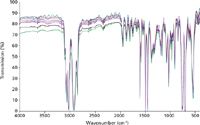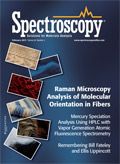Polystyrene Film as a Standard for Testing FT-IR Spectrometers
Polystyrene film is useful for routine checking of FT-IR spectrometer performance, but variations in film thickness and scattering can cause large variations in the results.
Several pharmacopeias propose two tests for the resolution of Fourier transform infrared (FT-IR) spectrometers using films of polystyrene. These tests are updated versions of tests that were originally developed for dispersive instruments with the result that one of the tests is unsuitable for an FT spectrometer. In some cases, the tests are defined in absorbance, making the results dependent on sample thickness. In others, the tests are in transmission so that the results depend on the scattering properties of the sample used. Because the requirements for these properties are not defined with sufficient precision in the pharmacopeias, instruments can fail tests simply because of using an unsuitable film. Here, we illustrate these problems and suggest improvements to the tests.
Polystyrene films have long been used for checking the general performance of infrared (IR) spectrometers and specific tests for wavenumber accuracy and resolution based on such films are enshrined in various pharmacopoeias (1–4). The purpose of this article is to draw attention to some limitations of the tests for resolution proposed in several pharmacopoeias.
Instrument manufacturers supply polystyrene films for routine checks of their spectrometers. The films have a matte finish that reduces the amplitude of interference fringes but also increases scattering. They vary significantly in thickness, scattering properties, and even chemical composition. Spectra of a number of such films are seen in Figure 1. The differences are unimportant for wavenumber accuracy tests because the tolerances in the tests, typically ±1 cm-1, are much greater than the variations seen between different commercial polystyrene films. If required for compliance, calibrated polystyrene wavenumber standards are available from sources such as the National Institute of Standards and Technology (NIST) (5). However, the resolution tests are more problematic because they are sensitive to both the thickness and the scattering properties of the films, as well as any residual fringes. A practical consequence of this is that instruments may fail resolution checks simply because of an unsuitable choice of test film.

Figure 1: Spectra of polystyrene films supplied by instrument manufacturers. The transmission at 4000 cm-1 varies between 71% and 85% because of differences in scattering. Interference fringes are clearly visible in one spectrum and are present at lower levels in two others.
Experimental
Spectra were measured on a PerkinElmer Frontier FT-IR spectrometer. The resolution was 4 cm-1 except where indicated, using medium Norton-Beer apodization. Eight different films were obtained from three instrument manufacturers. The thickness of some of the films was quoted as 0.038 mm and from relative band intensities the thickness of all films was estimated to be between 0.03 and 0.038 mm. In the spectra of some films there is a band at 964 cm-1 that is associated with the presence of butadiene.
Resolution Tests
Resolution tests are prescribed in some pharmacopoeias to facilitate comparisons with published reference spectra. These tests measure the depth of the trough between pairs of incompletely resolved peaks. This makes the results dependent on the lineshape, not just on the width at half height of isolated bands, which is the basis for published instrument specifications. The lineshapes of spectrometers from different manufacturers may differ for the same nominal resolution because of different choices of default apodization function. Although these differences are not significant for the purpose of identifying materials, they can make the difference between passing and failing a resolution test. For example, at 4 cm-1 resolution the band at 1601 cm-1 has a width at half height of approximately 10 cm-1. Changing the apodization from medium Norton-Beer to strong Norton-Beer increases this by less than 0.3 cm-1 but reduces the depth of the trough at 1583 cm-1 by 12%.

Figure 2: Regions of polystyrene spectrum indicating the points used for resolution tests.
The relevant regions of a polystyrene spectrum are seen in Figure 2. They were originally selected for dispersive instruments that had varying resolution across the frequency range. Typically the resolution at 3000 cm-1 could be poorer by a factor of three than that at 1000 cm-1. However, the resolution of Fourier transform (FT) spectrometers is essentially constant. The trough adjacent to the band at 1583 cm-1 is very sensitive to resolution at 4 cm-1 because the width at half height is 6.4 cm-1. However, the trough near 2850 cm-1 has a width at half height greater than 25 cm-1. When the resolution is downgraded from 4 to 8 cm-1 the depth of the trough at 2850 cm-1 changes by less than 10%, making it unsuitable as a test of resolution (Figure 3).

Figure 3: Polystyrene at 4 and 8 cm-1 resolution.
The European and Indian Pharmacopoeias specify the depths of the troughs in units of absorbance, while the Japanese and Chinese Pharmacopoeias use percent transmission (Table I). The use of transmission for these tests is unsound spectroscopically, but can perhaps be justified if transmission spectra are to be used for identification. Although there are recommended film thicknesses of 0.035 and 0.040 mm, these do not correspond to common commercial products. For example, the Trycite films (Dow) are available in thicknesses of 0.032 and 0.038 mm6. As absorbance is proportional to pathlength the trough depths in absorbance will vary linearly with film thickness. Figure 4 shows spectra of two films supplied by the same instrument manufacturer at different times where the trough depths are 0.332 and 0.403 AU at 2850 cm-1 and 0.100 and 0.130 AU at 1483 cm-1. The value of 0.332 AU is very close to the limit even though the test is extremely insensitive to resolution. Far from indicating poor resolution, this is merely the result of using a thin film.

Table I: Tests for 4 cm-1 resolution
The effect of film thickness is less straightforward in transmission than in absorbance. Although the trough depth in absorbance always increases with thickness, the depth in transmission may increase or decrease depending on the absolute transmission values involved. For typical films, the trough depth in absorbance at 1493 cm-1 increases with thickness and the change at 2850 cm-1 is fairly small.

Figure 4: Spectra of two polystyrene films with different thicknesses from the same instrument manufacturer.
When the measurements are made in transmission they become sensitive to scattering as well as thickness. In the spectra of Figure 1, the transmission at 4000 cm-1 of films supplied by three instrument manufacturers varies between 71% and 85%. This variation is attributed to scattering by the matte finish that is chosen to minimize interference fringes in the spectra. The depth of a trough measured in transmission will be inversely proportional to the baseline transmission, so that using a more scattering film increases the risk of failing a resolution test. Because scattering is lower at longer wavelengths, the effect is more significant at 2850 cm-1 than at 1483 cm-1. The variation caused by scattering can be removed by baseline subtraction, although this is not considered in the pharmacopoeias. A simple two-point subtraction using baseline points at 4000 and 2050 cm-1 greatly reduces the variation in test results for different films. For spectra of 11 films from different sources the relative standard deviation for the test at 2850 cm-1 was reduced from 6.0% to 3.2% (Table II).

Table II: Trough depths in percent transmission at 2850 cm-1 for 11 polystyrene films before and after baseline subtraction
Possible Improvements
It was necessary to test the resolution of dispersive spectrometers at different frequencies because they used multiple gratings and varying slit widths. However, this is unnecessary with FT spectrometers because a single test is sufficient.
Tests in absorbance are very sensitive to sample thickness. It would be preferable to specify a minimum film thickness as the current specification of "about 0.035 mm" falls between commercial products at 0.0318 and 0.0381 mm. Our experience is that films thicker than 0.035 mm do not cause problems. It is rather difficult for a user to measure the thickness of a film that does not show interference fringes, so it is certainly advisable to use only films of known thickness.
Tests in transmission are sensitive to scattering as well as to sample thickness. The effects of scattering can be eliminated by applying a baseline subtraction that forces the transmission values to 100% T at 4000 and 2050 cm-1. Alternatively, suitable films could be identified by specifying a minimum value such as 80% T for the transmission at 4000 cm-1.
Summary
Although a polystyrene film is useful for routine checking of FT-IR spectrometer performance, variations in film thickness and scattering can cause large variations in the results for the resolution tests described in pharmacopoeias. The test using the peak at 2850 cm-1 is insensitive to resolution but extremely sensitive to film thickness. It should not be used for FT-IR spectrometers.
R.A. Hoult, B. Perston, and R.A. Spragg are with PerkinElmer LAS in Seer Green, UK. Direct correspondence to: richard.spragg@perkinelmer.com.
References
(1) European Pharmacopoeia 6.0 Chapter 2.2.24 – Absorption Spectrophotometry, Infrared (The European Pharmacopoeia, Strasbourg, France, 2007).
(2) Indian Pharmacopoeia 2010, Chapter 2.4.6 – Infrared Absorption Spectrophotometry (Indian Pharmacopoeia Commission [IPC], Raj Nagar, Ghaziabad, India, 2010).
(3) Japanese Pharmacopoeia 15th edition 2008, Methods of Analysis – 1.7 Spectrophotometry in the infrared region (Japanese Pharmacopoeia, Japan, 2008).
(4) Chinese Pharmacopoeia 2005, Volume 1, Appendix V C (The Pharmacopoeia of the People's Republic of China [PPRC], 2005).
(5) Standard Reference Material 1921b (National Institute of Standards and Technology [NIST], Gaithersburg, Maryland, 1995).
(6) The Dow Chemical Company, www.dow.com/packaging/products/trycite.htm.

AI Shakes Up Spectroscopy as New Tools Reveal the Secret Life of Molecules
April 14th 2025A leading-edge review led by researchers at Oak Ridge National Laboratory and MIT explores how artificial intelligence is revolutionizing the study of molecular vibrations and phonon dynamics. From infrared and Raman spectroscopy to neutron and X-ray scattering, AI is transforming how scientists interpret vibrational spectra and predict material behaviors.
Real-Time Battery Health Tracking Using Fiber-Optic Sensors
April 9th 2025A new study by researchers from Palo Alto Research Center (PARC, a Xerox Company) and LG Chem Power presents a novel method for real-time battery monitoring using embedded fiber-optic sensors. This approach enhances state-of-charge (SOC) and state-of-health (SOH) estimations, potentially improving the efficiency and lifespan of lithium-ion batteries in electric vehicles (xEVs).
New Study Provides Insights into Chiral Smectic Phases
March 31st 2025Researchers from the Institute of Nuclear Physics Polish Academy of Sciences have unveiled new insights into the molecular arrangement of the 7HH6 compound’s smectic phases using X-ray diffraction (XRD) and infrared (IR) spectroscopy.